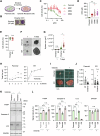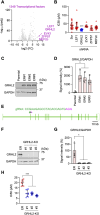GRHL2-HER3 and E-cadherin mediate EGFR-bypass drug resistance in lung cancer cells
- PMID: 39897079
- PMCID: PMC11782226
- DOI: 10.3389/fcell.2024.1511190
GRHL2-HER3 and E-cadherin mediate EGFR-bypass drug resistance in lung cancer cells
Abstract
Epidermal growth factor receptor (EGFR) is a major oncogenic protein, and thus EGFR-targeting therapies are widely used in patients with various types of cancer, including lung cancer. However, resistance to EGFR inhibitors, such as erlotinib, presents a significant challenge in treating lung cancer. In this study, we established an EGFR-independent, erlotinib-resistant (ER) phenotype in lung cancer A549 cells by exposing them to erlotinib for an extended period. The resulting ER cells exhibited a dramatic increase in erlotinib resistance, a decreased EGFR protein level, and enhanced tumor growth, suggesting a robust mechanism bypassing EGFR inhibition. RNA sequencing identified the transcription factor GRHL2 as a critical player in this resistance. GRHL2 was upregulated in ER cells, and its knockdown and knockout significantly reduced erlotinib resistance. Further analysis revealed that GRHL2 upregulates the receptor tyrosine kinase HER3, and that HER3 knockdown similarly decreases the IC50 for erlotinib. Additionally, ER cells showed increased cell-cell adhesion, linked to upregulated E-cadherin. E-cadherin was found to be vital for erlotinib resistance, largely independent of GRHL2, highlighting multiple parallel pathways sustaining resistance. These findings provide a novel mechanism of drug resistance and suggest that combination therapies targeting both GRHL2-HER3 and E-cadherin-mediated pathways may be necessary to overcome erlotinib resistance in lung cancer.
Keywords: EGFR; GRHL2; HER3; cadherin; drug resistance; lung cancer.
Copyright © 2025 Ito, Iwata, Adachi, Sesaki and Iijima.
Conflict of interest statement
The authors declare that the research was conducted in the absence of any commercial or financial relationships that could be construed as a potential conflict of interest. The author(s) declared that they were an editorial board member of Frontiers, at the time of submission. This had no impact on the peer review process and the final decision
Figures









Similar articles
-
The pan-HER family tyrosine kinase inhibitor afatinib overcomes HER3 ligand heregulin-mediated resistance to EGFR inhibitors in non-small cell lung cancer.Oncotarget. 2015 Oct 20;6(32):33602-11. doi: 10.18632/oncotarget.5286. Oncotarget. 2015. PMID: 26418897 Free PMC article.
-
Anti-HER3 monoclonal antibody patritumab sensitizes refractory non-small cell lung cancer to the epidermal growth factor receptor inhibitor erlotinib.Oncogene. 2016 Feb 18;35(7):878-86. doi: 10.1038/onc.2015.142. Epub 2015 May 11. Oncogene. 2016. PMID: 25961915
-
Axl mediates acquired resistance of head and neck cancer cells to the epidermal growth factor receptor inhibitor erlotinib.Mol Cancer Ther. 2013 Nov;12(11):2541-58. doi: 10.1158/1535-7163.MCT-13-0170. Epub 2013 Sep 11. Mol Cancer Ther. 2013. PMID: 24026012
-
Treatment strategies and outcomes for patients with EGFR-mutant non-small cell lung cancer resistant to EGFR tyrosine kinase inhibitors: Focus on novel therapies.Lung Cancer. 2022 Aug;170:41-51. doi: 10.1016/j.lungcan.2022.05.011. Epub 2022 May 21. Lung Cancer. 2022. PMID: 35714425 Review.
-
HER3-targeted therapeutic antibodies and antibody-drug conjugates in non-small cell lung cancer refractory to EGFR-tyrosine kinase inhibitors.Chin Med J Pulm Crit Care Med. 2023 Feb 27;1(1):11-17. doi: 10.1016/j.pccm.2022.12.001. eCollection 2023 Mar. Chin Med J Pulm Crit Care Med. 2023. PMID: 39170873 Free PMC article. Review.
Cited by
-
Prognostic role and functional impact of cadherin genes in non-small cell lung cancer tumorigenesis: mechanistic insights from in silico and in vitro analyses.PeerJ. 2025 Aug 19;13:e19785. doi: 10.7717/peerj.19785. eCollection 2025. PeerJ. 2025. PMID: 40860670 Free PMC article.
References
LinkOut - more resources
Full Text Sources
Research Materials
Miscellaneous

